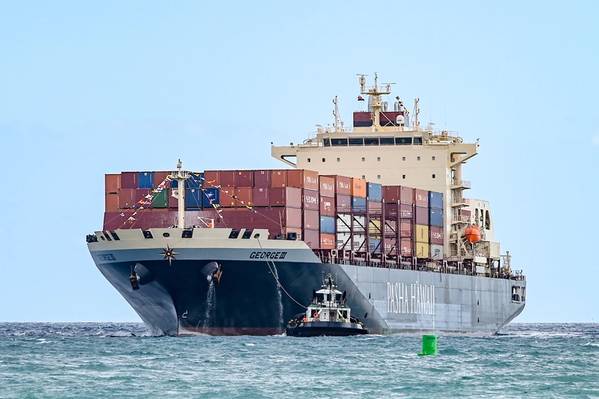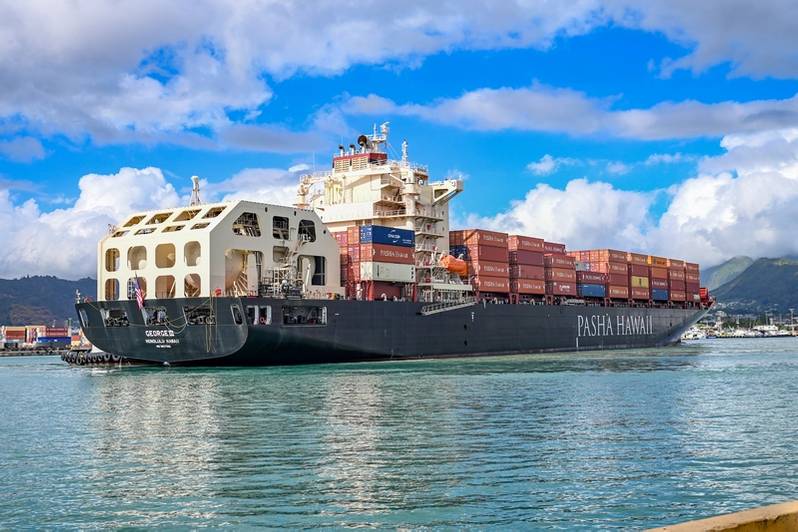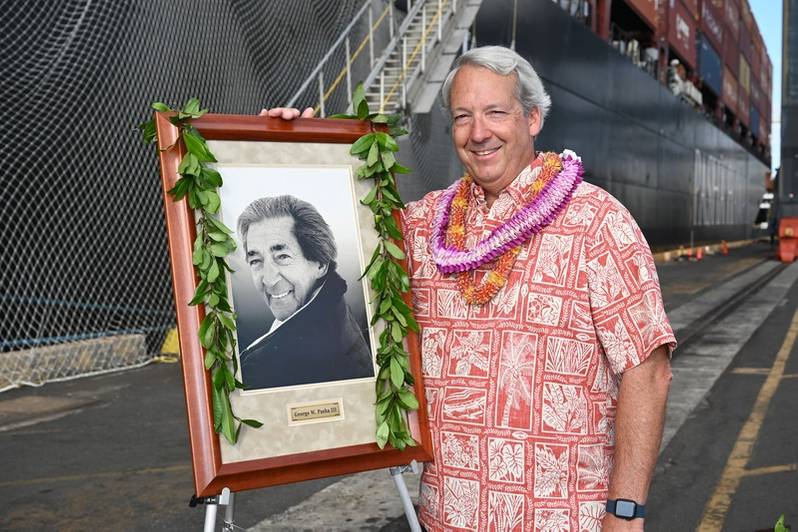
Operating on Liquefied Natural Gas (LNG) from day one in service, the MV George III, the first of Pasha Group’s two new ‘Ohana Class’, Jones Act-qualified containerships, features a state-of-the-art engine, an optimized hull form, and an underwater propulsion system with a high-efficiency rudder and propeller. George III is the first LNG-powered vessel to fuel on the West Coast and the first to serve Hawaii. The 774-ft. Jones Act vessel surpasses the International Maritime Organization (IMO) 2030 emission standards for ocean vessels. With the first delivered and the second on the way, George Pasha, IV, President and CEO, Pasha Hawaii and Ed Washburn, SVP, Fleet Operations, Pasha Hawaii, discuss the challenges and reward of building two new LNG-fueled containerships from scratch.
Earlier this year Pasha Hawaii welcomed the newest member to its containership fleet with the arrival of George III at the Port of Long Beach in California, where it began its maiden voyage to Honolulu, Hawaii. This is the first liquefied natural gas (LNG) powered vessel to fuel on the West Coast and the first to serve Hawaii. The 774-ft. containership was built in Brownsville, Texas, by Keppel AmFELS, marking the first of two new Ohana Class containerships to join Pasha Hawaii’s fleet, serving the Hawaii/Mainland trade lane.
Operating fully on natural gas from day one, the new Jones Act vessel surpasses the IMO 2030 emission standards for ocean vessels, and energy efficiencies are also achieved with a state-of-the-art engine, an optimized hull form, and an underwater propulsion system with a high-efficiency rudder and propeller.
Named after George Pasha IV’s late father, the second vessel in the Ohana Class, the Janet Marie which is named after George Pasha IV’s mother, was scheduled to join Pasha Hawaii’s fleet at the end of 2022.
While the project was ultimately a success, there were some roadblocks to navigate along the way. Shipbuilding by its very nature is fraught with potential risks, premised mainly on the lack of serial production which allows efficient manufacturers to work out the bugs. Building an original design with an increasingly common, yet still far from mainstream LNG fuel system, raised the risk profile.
“The biggest obstacle was building a ship during a global pandemic,” said Ed Washburn, SVP, Fleet Operations, Pasha Hawaii. When the pandemic started, the shipyard starting to shut down because, at the time, “shipyard workers were not essential workers.” But The Pasha Group persisted, and “through the Infrastructure Securities Act and together with American Maritime Partnership, we were able to contribute to that act and include shipyard works as essential workers. In addition, travel restrictions created havoc with the delivery and commissioning of key equipment, some of which was coming in from Europe and South Korea. “I would say that was the largest obstacle.”
Another obstacle was not pandemic, rather regulatory, as “we're the first ship in the United States to be built to the international gas fuel ship code,” said Washburn. “Our U.S. flag state regulators had to interpret that code, and they interpreted it differently than the international market in some instances. We felt a little bit of pain on the interpretation on some rules that were different than the international market.”
As shipowners globally mull the alternative fuel future, he offers some insight on The Pasha Group’s choice of LNG.
“I would advocate for it, but don't expect it to be easy. One of the other challenges is fuel infrastructure? That's always been a chicken and the egg type scenario, and I've been looking alternative fuels almost my whole career,” said Washburn. To mitigate that risk, “we developed a joint venture called West Coast Clean Fuels,” said Washburn. “Part of our joint venture is World Fuel Services who deliver 70% of the bunkers in the LA Basin and also clean marine energy who specializes in LNG.”
“I would say if you want to help your communities and help the environment, LNG is the way to go,” said Washburn. “It is the only fuel that is capable today of running a high-horsepower ocean going vessel with an alternative fuel. We're going to pass the 2030 IMO standards by a great deal. 2050 may be a challenge, but it is the right fuel for the future and the best fuel available.”
The Ohana class was designed from scratch via collaboration between the shipowner and ship yard to meet The Pasha Group’s specific needs, and offers several additional features aimed at operational efficiency and emission reduction.
“What we have today is the most hydrodynamically efficient container ship in the world,” boasts Washburn. “Our ship went through computational fluid dynamics design for hull form that was checked and further optimized. The hull form went to the Maritime Research Institute of the Netherlands (MARIN), and they model tested it and developed a twisted, leading-edge rudder and a high efficiency propeller to match that hull form.
Apart from the hull, the ship features Hempel self-polishing copolymer paints; a full-spectrum of modern bridge kit – hardware and software to ensure the best route is plotted and followed; and Selective Catalytic Reduction (SCR) on the auxiliary engines to reduce NOx. “All the equipment is state-of-the-art,” said Washburn. “Our budget was $225 million, but if we had $2.25 billion, I don't think we could have done much more.”
Apart from the two newbuilds in the Ohana Class, The Pasha Group is currently in the process of converting one of its 42-year-old steamships. “We'll take delivery of her in April [2023] with an LNG power plant,” said Pasha IV. “That will leave us with one more reserve ship to decide whether we're going to invest further and convert that ship to LNG.”
 Photo Copyright Toby Manuput/The Pasha GroupPasha Group Celebrates 75
Photo Copyright Toby Manuput/The Pasha GroupPasha Group Celebrates 75
“What started out as a personal vehicle storage company has evolved into a world-class global logistics and transportation company,” said George Pasha IV. “As we mark our 75th anniversary and welcome George III to Long Beach, we are proud to continue my family’s legacy of innovation and environmental stewardship, while recognizing our employees as our extended ‘Ohana’.”
“We started out with humble beginnings. My grandfather had two gas stations in San Francisco, which [essentially] formed the current company,” said George Pasha IV. “My dad joined him in high school and decided that he'd like to do something bigger and different than just gas station work. So we built, over about a 50-year period, a logistics and transportation company, and started handling new vehicles for the OEMs. That was the initial legacy business. From there we diversified into break bulk and other commodities.”
According to George Pasha, IV, the company took a turn into shipping when around 2000 “General Motors encouraged the industry to build a pure car truck carrier for the Hawaii trade lane. In 2005, we delivered the first pure car truck carrier and still the only pure car truck carrier in the Jones Act trade. In 2015, we were getting ready to deliver a second ship, a combination ship for the Hawaii trade lane. We were talking to the folks at Horizon Lines, and those discussions led to an opportunity to acquire the Horizon Hawaii assets … quite a leap for us.”
The Horizon acquisition, according to George Pasha IV, “just about doubled the size of our company in every way that you can measure it from a top line revenue, head count, and EBITA point of view. So today as we look at 2022, we're a little more than a billion dollars in revenue, with about 2200 teammates that support the day-to-day operation of the business.”
While the new LNG ships are a physical manifestation of the Pasha Group’s commitment to ESG matters, it’s not the only move as George Pasha IV said the company’s ties to the community and environment concerns are long-tenured.
“The LNG ships are certainly one manifestation, but we've had the opportunity to pioneer a number of terminal projects,” he said. “One was in the Port of Los Angeles and called Green Omni Terminal that started with solar battery power electric vehicles, including heavy cargo handling equipment. We were early on, and so we've had some struggles trying to make all of that work, but we had some support from MarAd grant money to install a microgrid and take that to a more practical next-level as well.”
Keeping the family business growing and successful is the mantra of George Pasha IV and his management team today. “First and foremost, we're a family business based on family values. My grandfather was very hands-on in his service station work; he was visible, very much a part of the success of the team from the floor plates up. That's certainly still the case with the company today.”
As his grandfather was a product of the depression, he was more conservative by nature, whereas “my dad grew up in the 50s, a more idyllic time,” said George Pasha IV. “He was much more entrepreneurial and aggressive, and he certainly was a great early steward in terms of setting us off into the trajectory that we're in now. It's with great pride that we're able to put his name on the stern of the George III, and we wish he was here. My grandfather would love to be in the engine room of the George III; he was an automotive engineer, and he would be extremely proud of and interested in what's happened over the course of the last 75 years.”
 George Pasha IV pictured with a photo of his father, and the new ship's namesake, George III. Photo Copyright Toby Manuput/The Pasha Group
George Pasha IV pictured with a photo of his father, and the new ship's namesake, George III. Photo Copyright Toby Manuput/The Pasha Group



